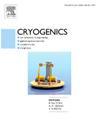The effects of cavitation on the control performance of a cryogenic valve
IF 2.1
3区 工程技术
Q3 PHYSICS, APPLIED
引用次数: 0
Abstract
Cryogenic valves have been widely used in the transmission systems of cryogenic fluid mediums such as LNG, LN2, LO2 and other liquefied gas, which plays important roles in the stability and reliability of the system operation. Cavitation makes serious erosion and damage on the valve core and pipeline surface, which leads to the leakage and noise problems in cryogenic valves. Cryogenic cavitation phenomenon usually produces vibration and noise hazards, which significantly affect the stable operation of the system. In this study, Based on the original ZGB cavitation model, combined with the thermodynamic effect of cryogenic fluid, the cavitation model is modified, and a cavitation model suitable for cryogenic fluid is obtained. The accuracy and applicability of the modified cavitation model are verified by the combination of experiment and numerical simulation. Taking different openings as the research variables, the cryogenic cavitation under different openings was obtained, and the influence of cavitation on the control performance of the cryogenic ball valve was analyzed. The results show that when the spool is in a large opening, cavitation has a great influence on the control performance of the ball valve. The volume and flow instability of the cavity change with the opening. And the spatial and temporal distribution of the vortex structure in the cavitation flow field is highly consistent with the evolution of the cavitation. The energy loss in the cavitation flow field is quantified by the entropy characterization method, and the evolution process of cavitation is characterized by different types of entropy production distribution. The results show that the outlet of the spool is the concentrated area of entropy production distribution, and in the cavitation flow field, the entropy production caused by direct dissipation (EPDD) and the entropy production caused by turbulent dissipation (EPTD) account for the main part of the total entropy production in the cavitation flow field.
气蚀对低温阀门控制性能的影响
低温阀门已广泛应用于LNG、LN2、LO2等低温流体介质的输送系统中,对系统运行的稳定性和可靠性起着重要作用。气蚀对阀芯和管道表面造成严重的侵蚀和破坏,导致低温阀门的泄漏和噪声问题。低温空化现象通常会产生振动和噪声危害,严重影响系统的稳定运行。本研究在原有ZGB空化模型的基础上,结合低温流体的热力学效应,对空化模型进行了修正,得到了适用于低温流体的空化模型。通过实验与数值模拟相结合,验证了修正空化模型的准确性和适用性。以不同开度为研究变量,得到了不同开度下的低温空化,并分析了空化对低温球阀控制性能的影响。结果表明,阀芯大开度时,空化现象对球阀的控制性能影响较大。腔体的体积和流动不稳定性随开度的变化而变化。空化流场中涡结构的时空分布与空化的演化高度一致。利用熵表征方法量化了空化流场的能量损失,并以不同类型的熵产分布来表征空化的演化过程。结果表明:阀芯出口是熵产分布的集中区域,在空化流场中,直接耗散(EPDD)和湍流耗散(EPTD)产生的熵产占空化流场总熵产的主要部分。
本文章由计算机程序翻译,如有差异,请以英文原文为准。
求助全文
约1分钟内获得全文
求助全文
来源期刊

Cryogenics
物理-热力学
CiteScore
3.80
自引率
9.50%
发文量
0
审稿时长
2.1 months
期刊介绍:
Cryogenics is the world''s leading journal focusing on all aspects of cryoengineering and cryogenics. Papers published in Cryogenics cover a wide variety of subjects in low temperature engineering and research. Among the areas covered are:
- Applications of superconductivity: magnets, electronics, devices
- Superconductors and their properties
- Properties of materials: metals, alloys, composites, polymers, insulations
- New applications of cryogenic technology to processes, devices, machinery
- Refrigeration and liquefaction technology
- Thermodynamics
- Fluid properties and fluid mechanics
- Heat transfer
- Thermometry and measurement science
- Cryogenics in medicine
- Cryoelectronics
 求助内容:
求助内容: 应助结果提醒方式:
应助结果提醒方式:


